The Micro-Flow Mechanism of Polymer Flooding in Dual Heterogeneous Reservoirs Considering the Wettability
Abstract
:1. Introduction
2. Modeling
2.1. Mathematical Model
2.2. Boundary Conditions
- Give initial value α, V, U, p, ρ, μ, obtain parameters Re, We, Fr, Ca;
- Solve the Equation (3) to obtain an updated volume fraction α′;
- Solve Equation (2) to get an intermediate velocity value U′;
- PISO-Loop, and obtain U″;
- Increase the time step, go back to the first step, and loop steps (1)~(4) until the accuracy requirement is met.
2.3. Physical Model
3. Results and Discussion
3.1. Effect of Particle Shape on Micro-Flow Characteristics
3.1.1. Oil Saturation Distribution
3.1.2. Pressure Distribution
3.2. Effect of Wettability on Micro-Flow Characteristics
3.2.1. Effect of Wettability on Displacement Characteristics
3.2.2. Characteristics of Pressure Distribution
3.3. Effect of Gravity on Micro-Flow Characteristics
3.3.1. Effect of Gravity on Micro-Flow Mechanism of Polymer Flooding
3.3.2. Effect of Wettability on Micro-Flow Mechanism of Polymer Flooding
4. Conclusions
Author Contributions
Funding
Institutional Review Board Statement
Data Availability Statement
Conflicts of Interest
Nomenclature
| Ca | Capillary force |
| CT scanning technology | Computed tomography scanning technology |
| Fr | Froude number |
| g | Dimensionless gravitational acceleration |
| K | Permeability of reservoirs |
| L | Characteristic length, m |
| n | Interface normal vector |
| nw | Wall unit normal vector |
| p | Dimensionless pressure |
| Re | Reynolds number |
| tw | Wall unit tangent vector |
| U | Dimensionless velocity vector |
| V | Characteristic velocity, m/s |
| We | Weber number |
| α | Phase fraction of two phases |
| κ | Mean curvature of free surface |
| μ | Dynamic viscosity of fluid, Pa·s |
| μ1 | Dynamic viscosity of displacement fluid, Pa·s |
| μ2 | Dynamic viscosity of displaced fluid, Pa·s |
| θ | Contact angle |
| ρ | Density of fluid, kg/m3 |
| ρ1 | Density of displacement fluid, kg/m3 |
| ρ2 | Density of displaced fluid, kg/m3 |
| σ | Interfacial tension, N/m |
References
- Seright, R.S.; Wang, D. Polymer flooding: Current status and future directions. Pet. Sci. 2023, 20, 910–921. [Google Scholar] [CrossRef]
- Tan, F.; Qin, J.; Wang, X.; Lv, J.; Ma, C.; Liu, W.; Zhang, C. Study on the oil displacement mechanism of different SP Binary flooding schemes for a conglomerate reservoir based on a microfluidic model. Ind. Eng. Chem. Res. 2023, 62, 5453–5467. [Google Scholar] [CrossRef]
- Zhong, H.; He, Y.; Zhao, X.; Peng, X. Theoretical study on the micro-flow mechanism of polymer flooding in a double heterogeneous oil layer. Energies 2022, 15, 3236. [Google Scholar] [CrossRef]
- Hazarika, K.; Gogoi, S.B.; Kumar, A. Polymer flooding and its effects on enhanced oil recovery special reference to Upper Assam Basin. Pet. Res. 2023, 8, 54–62. [Google Scholar] [CrossRef]
- Mokhtari, F.; Riahi, S.; Rostami, B. Experimental study of secondary and tertiary modes combined low salinity water and polymer flooding in sandstone porous media. Can. J. Chem. Eng. 2023, 101, 1095–1108. [Google Scholar] [CrossRef]
- Silva, I.P.G.; Aguiar, A.A.; Rezende, V.P.; Monsores, A.L.; Lucas, E.F. A polymer flooding mechanism for mature oil fields: Laboratory measurements and field results interpretation. J. Pet. Sci. Eng. 2018, 161, 468–475. [Google Scholar] [CrossRef]
- Azad, M.S.; Trivedi, J.J. Quantification of the viscoelastic effects during polymer flooding: A critical review. SPE J. 2019, 24, 2731–2757. [Google Scholar] [CrossRef]
- Zhong, H.; Zhang, W.; Liu, Y.; Yin, H. The micro-flow mathematical model study on viscoelastic polymer displacement viscous oil. Earth Sci. J. China Univ. Geosci. 2017, 42, 1364–1372. [Google Scholar]
- Zhong, H.; Zhang, W.; Fu, J.; Lu, J.; Yin, H. The performance of polymer flooding in heterogeneous type II reservoirs-an experimental and field investigation. Energies 2017, 10, 454. [Google Scholar] [CrossRef]
- Liu, W.; Luo, L.; Liao, G.; Zuo, L.; Wei, Y.; Jiang, W. Experimental study on the mechanism of enhancing oil recovery by polymer-surfactant binary flooding. Pet. Explor. Dev. 2017, 44, 600–607. [Google Scholar] [CrossRef]
- Zeynalli, M.; Alfazazi, U.; Mushtaq, M.; Al-Shalabi, E.W.; AlAmeri, W. Recent advancements in viscoelastic polymer flooding EOR applications in carbonates and sandstones. In Proceedings of the ADIPEC, SPE-211481-MS, Abu Dhabi, United Arab Emirates, 31 October 2022. [Google Scholar]
- Pothula, G.K.; Vij, R.K.; Bera, A. An overview of chemical enhanced oil recovery and its status in India. Pet. Sci. 2023, 20, 2305–2323. [Google Scholar] [CrossRef]
- Sharafi, M.S.; Jamialahmadi, M.; Hoseinpour, S. Modeling of viscoelastic polymer flooding in core-scale for prediction of oil recovery using numerical approach. J. Mol. Liq. 2018, 250, 295–306. [Google Scholar] [CrossRef]
- Zhu, W.; Li, H.; Chen, Z.; Song, Z. Pore-scale experiments reveal distinct flow field of polymer flooding with viscoelasticity loss by high salinity. Colloids Surf. A Physicochem. Eng. Asp. 2023, 668, 131473. [Google Scholar] [CrossRef]
- Chen, C.; Wang, S.; Harwell, J.H.; Shiau, B. Polymer-free viscoelastic fluid for improved oil recovery. Fuel 2021, 292, 120331. [Google Scholar] [CrossRef]
- Chami, S.; Joly, N.; Bocchetta, P.; Martin, P.; Aliouche, D. Polyacrylamide grafted xanthan: Microwave-assisted synthesis and rheological behavior for polymer flooding. Polymers 2021, 13, 1484. [Google Scholar] [CrossRef] [PubMed]
- Wang, D.; Cheng, J.; Yang, Q. Viscous-elastic polymer can increase micro-scale displacement efficiency in cores. Acta Pet. Sin. 2000, 21, 45–51. [Google Scholar]
- Xia, H.; Wang, D.; Liu, Z.; Yang, Q. Study on the mechanism of polymer solution with viscoelastic behavior increasing microscopic oil displacement efficiency. Acta Pet. Sin. 2004, 28, 29–31. [Google Scholar]
- Clemens, T.; Tsikouris, K.; Buchgraber, M.; Castanier, L.; Kovscek, A. Pore-scale evaluation of polymers displacing viscous oil-computational-fluid-dynamics simulation of micromodel experiments. SPE Reserv. Eval. Eng. 2013, 16, 144–154. [Google Scholar] [CrossRef]
- Tan, F.; Xu, C.; Wang, X.; Chen, Y.; Cheng, H.; Zhang, J.; Peng, S. Differences in microscopic porous flow mechanisms of water flooding and polymer flooding for conglomerate reservoir. Acta Pet. Sin. 2016, 37, 1414–1427. [Google Scholar]
- Zhou, Y.; Wang, D.; Wang, Z.; Cao, R. The formation and viscoelasticity of pore-throat scale emulsion in porous media. Pet. Explor. Dev. 2017, 44, 110–116. [Google Scholar] [CrossRef]
- Fang, Y.; Yang, E.; Guo, S.; Cui, C.; Zhou, C. Study on micro remaining oil distribution of polymer flooding in Class-II B oil layer of Daqing Oilfield. Energy 2022, 254, 124479. [Google Scholar] [CrossRef]
- Xin, X.; Yu, G.; Wu, K.; Dong, X.; Chen, Z. Polymer flooding in heterogeneous heavy oil reservoirs: Experimental and simulation studies. Polymers 2021, 13, 2636. [Google Scholar] [CrossRef] [PubMed]
- Zhong, H.; He, Y.; Yang, E.; Bi, Y.; Yang, T. Modeling of microflow during viscoelastic polymer flooding in heterogenous reservoirs of Daqing Oilfield. J. Pet. Sci. Eng. 2022, 210, 110091. [Google Scholar] [CrossRef]
- Zhang, X. Study of polymer flooding in heterogeneous porous media by using nuclear magnetic resonance. Energy Eng. J. Assoc. Energy Eng. 2021, 118, 1453–1467. [Google Scholar] [CrossRef]
- Lu, X.; Cao, B.; Xie, K.; Cao, W.; Liu, Y.; Zhang, Y.; Wang, X.; Zhang, J. Enhanced oil recovery mechanisms of polymer flooding in a heterogeneous oil reservoir. Pet. Explor. Dev. 2021, 48, 148–155. [Google Scholar] [CrossRef]
- Fu, H.; Bai, Z.; Guo, H.; Yang, K.; Guo, C.; Liu, M.; Liang, L.; Song, K. Remaining oil distribution law and development potential analysis after polymer flooding based on reservoir architecture in Daqing Oilfield, China. Polymers 2023, 15, 2137. [Google Scholar] [CrossRef]
- Hamidpour, E.; Mirzaei-Paiaman, A.; Ramazani, S.A.; Hatami, A. Analysis of capillary-viscous-gravity forces in biopolymer flooding with a sensitivity analysis on polymer and porous medium parameters. J. Dispers. Sci. Technol. 2014, 35, 1764–1773. [Google Scholar] [CrossRef]
- Rezaeiakmal, F.; Parsaei, R.; Shafiabadi, A.; Rezaei, A. Insights into the flow behaviour of the pre-generated polymer enhanced foam in heterogeneous porous media during tertiary oil recovery: Effect of gravitational forces. J. Pet. Sci. Eng. 2022, 213, 110385. [Google Scholar]
- Yue, P.; Feng, J.J.; Liu, C.; Shen, J. A diffuse-interface method for simulating two-phase flows of complex fluids. J. Fluid Mech. 2004, 515, 293–317. [Google Scholar] [CrossRef]
- Boyer, F.; Lapuerta, C.; Minjeaud, S.; Piar, B.; Quintard, M. Cahn-Hilliard/Navier-Stokes model for the simulation of three-phase flows. Transp. Porous Media 2010, 82, 463–483. [Google Scholar] [CrossRef]
- Banitabaei, S.A.; Amirfazli, A. Droplet impact onto a solid sphere: Effect of wettability and impact velocity. Phys. Fluids 2017, 29, 062111. [Google Scholar] [CrossRef]
- Shen, J. Modeling and numerical approximation of two-phase incompressible flows by a phase-field approach. Multiscale Model. Anal. Mater. Simul. 2011, 22, 147–195. [Google Scholar]
- Jacqmin, D.A. Contact-line dynamics of a diffuse fluid interface. J. Fluid Mech. 2000, 402, 57–88. [Google Scholar] [CrossRef]
- Yiotis, A.G.; Psihogios, J.; Kainourgiakis, M.E.; Papaioannou, A.; Stubos, A.K. A lattice Boltzmann study of viscous coupling effects in immiscible two-phase flow in porous media. Colloids Surf. A Physicochem. Eng. Asp. 2007, 300, 35–49. [Google Scholar] [CrossRef]
- Avraam, D.G.; Payatakes, A.C. Flow mechanism, relative permeabilities, and coupling effects in steady-state two-phase flow through porous media. The case of strong wettability. Ind. Eng. Chem. Res. 1999, 38, 778–786. [Google Scholar] [CrossRef]
- Hizir, F.E.; Hardt, D.E. Phase-field modeling of liquids splitting between separating surfaces and its application to high-resolution roll-based printing technologies. Phys. Fluids 2017, 29, 052007. [Google Scholar] [CrossRef]
- Wang, Y.; Rohlfs, W.; Ming, P. Numerical simulation of coalescence-induced self-propelled droplet jumping: Based on an improved VOF method. J. Eng. Thermophys. 2022, 43, 1541–1546. [Google Scholar]
- Deng, S.; Lv, W.; Liu, Q.; Leng, Z.; Li, T.; Liu, H.; Gu, H.; Xu, C.; Zhang, X.; Lu, X. Research on displacement mechanism in conglomerate using CT scanning method. Pet. Explor. Dev. 2014, 41, 330–335. [Google Scholar] [CrossRef]
- Xu, J.; Wang, L.; Zhang, B. Transient pressures in a polymer-flooding reservoir with double permeability. J. Tsinghua Univ. 2004, 44, 236–239. [Google Scholar]
- Liu, Z.; Li, Y.; Leng, R.; Liu, Z.; Chen, X.; Hejazi, H. Effects of pore structure on surfactant/polymer flooding-based enhanced oil recovery in conglomerate reservoirs. Pet. Explor. Dev. 2020, 47, 129–139. [Google Scholar] [CrossRef]
- Su, H.; Zhou, F.; Liu, Y.; Gao, Y.; Cheng, B.; Dong, R.; Liang, T.; Li, J. Pore-scale investigation on occurrence characteristics and conformance control mechanisms of emulsion in porous media. Pet. Explor. Dev. 2021, 48, 1241–1249. [Google Scholar] [CrossRef]


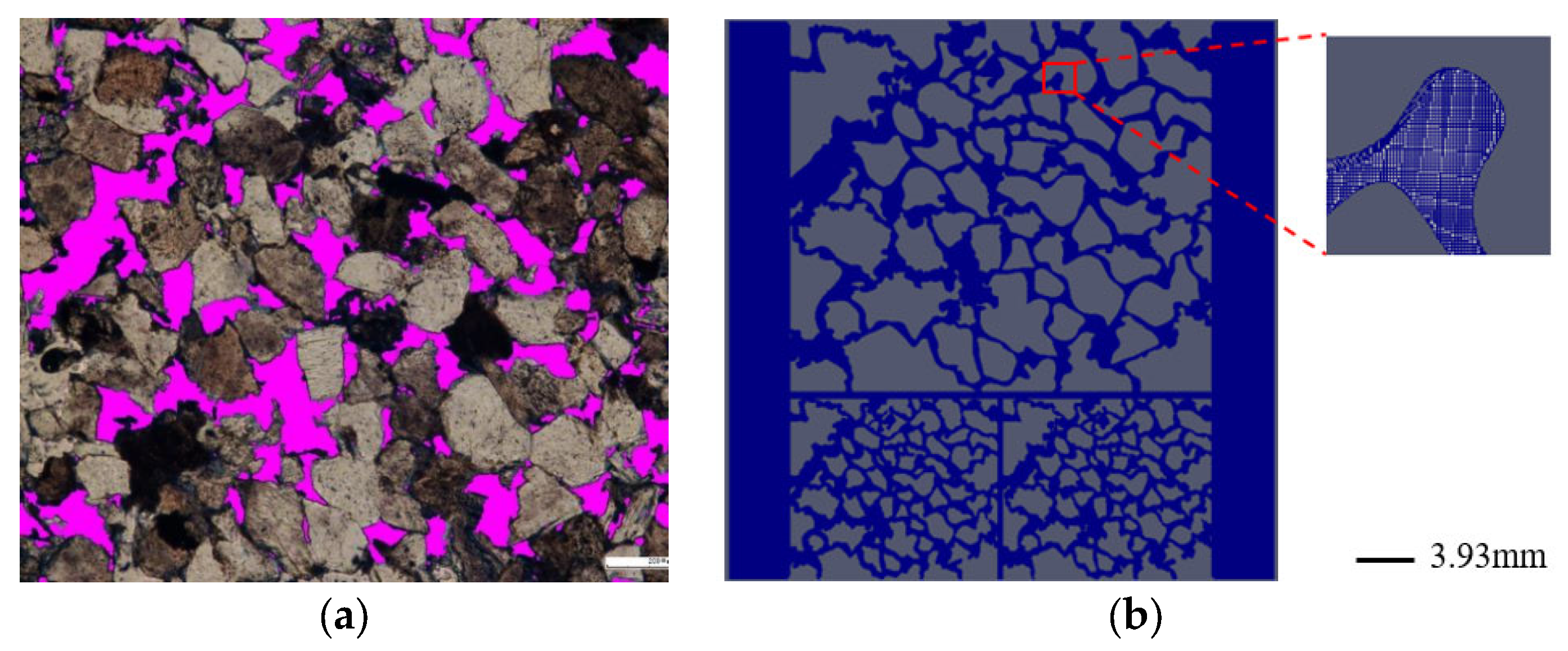



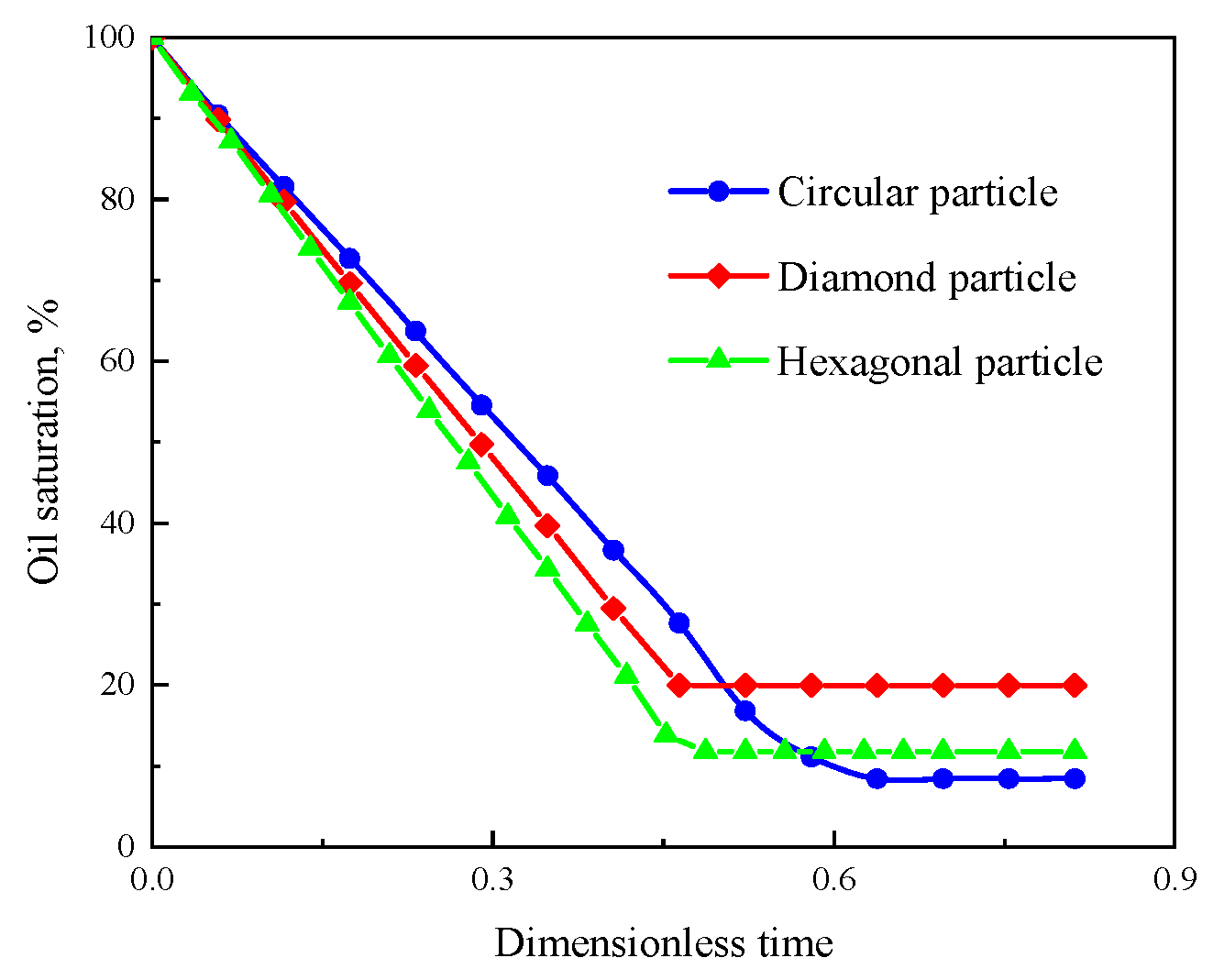
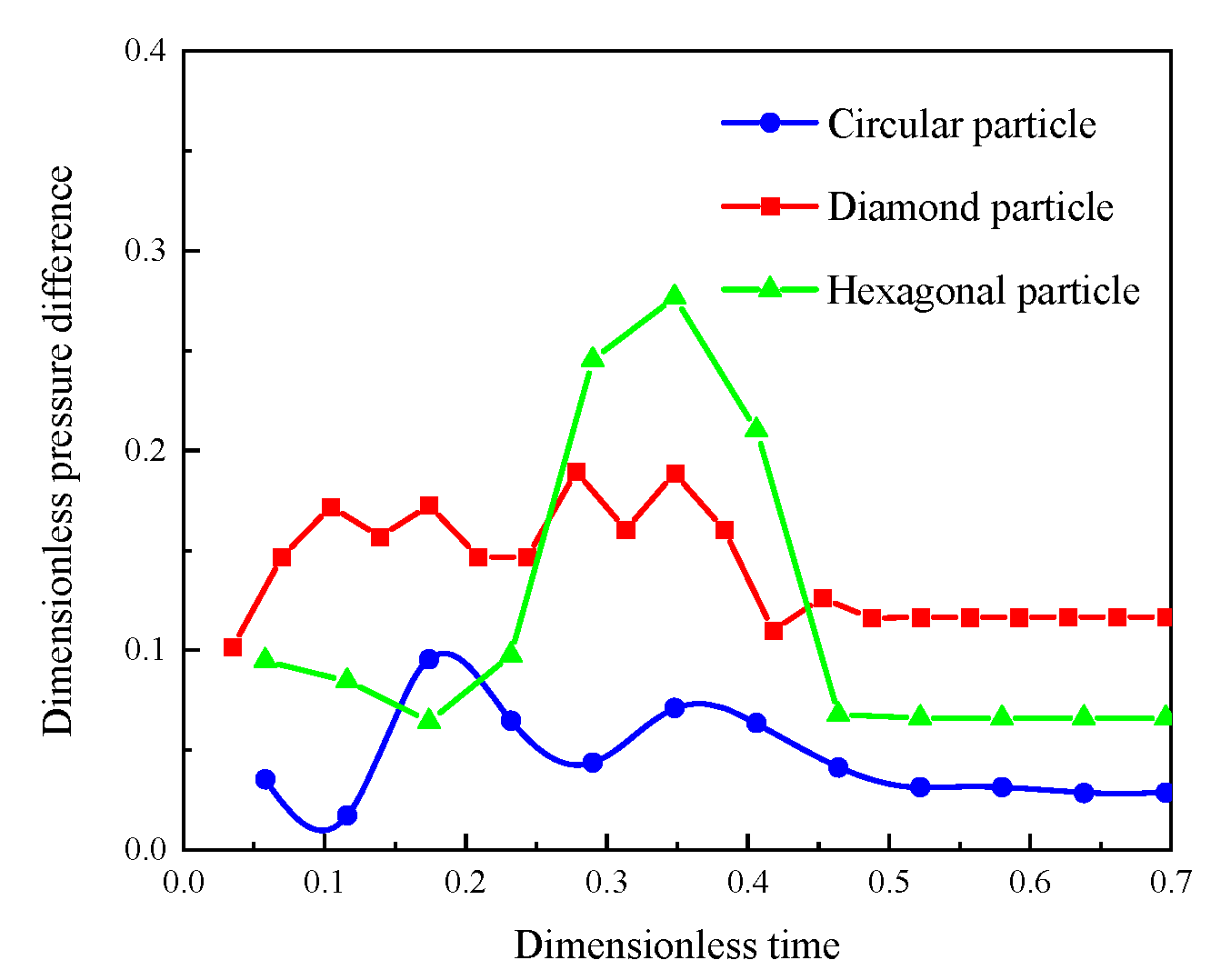

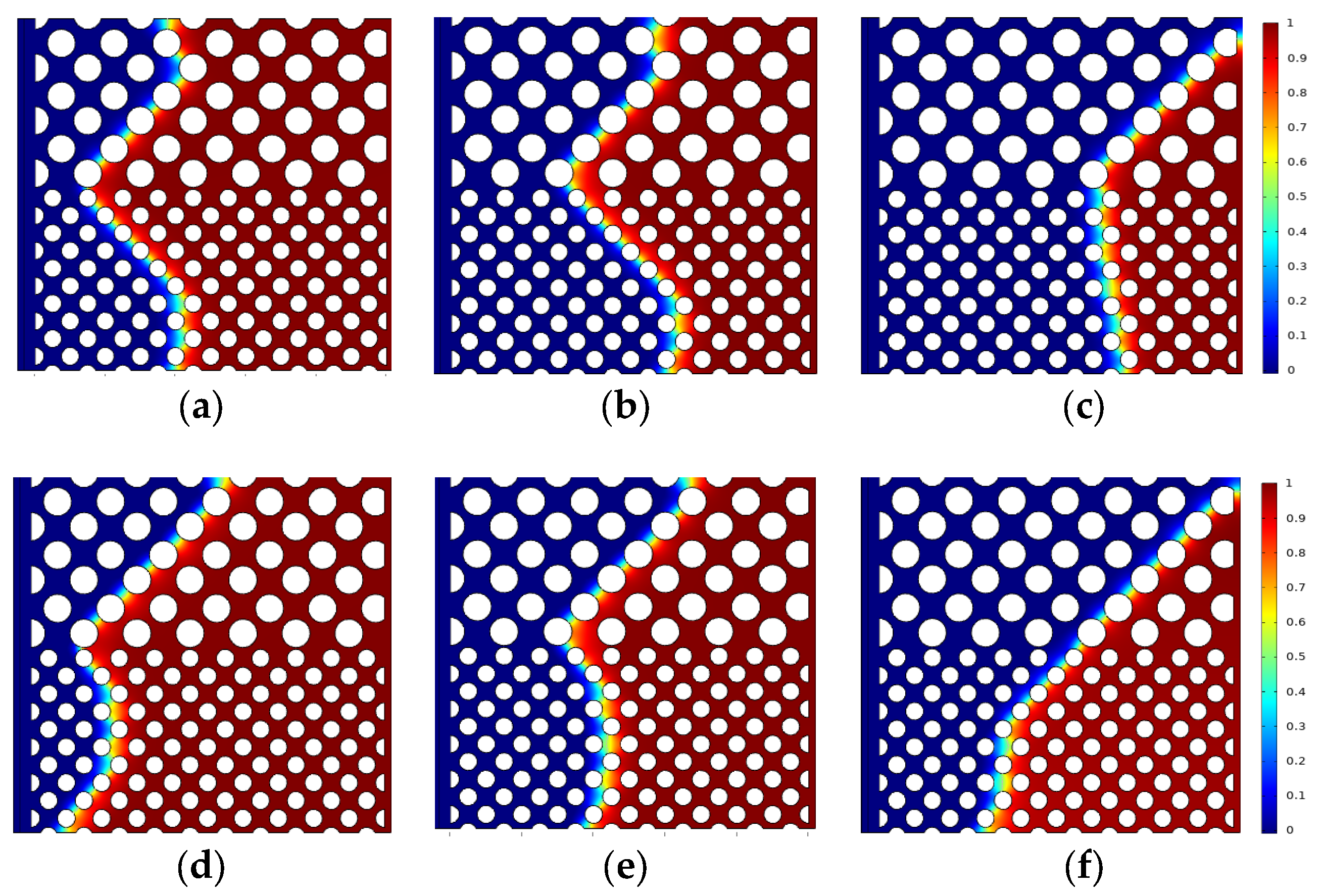
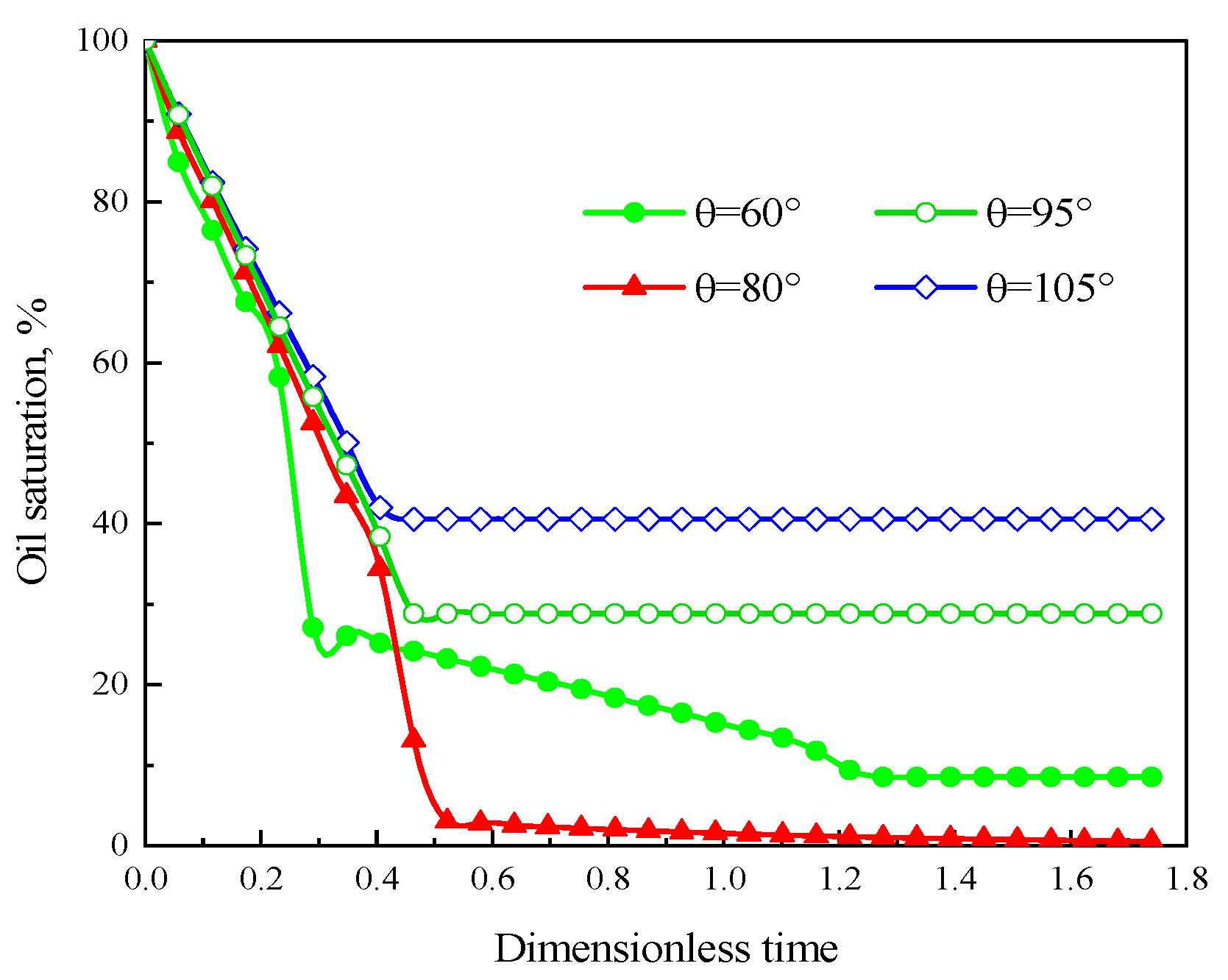
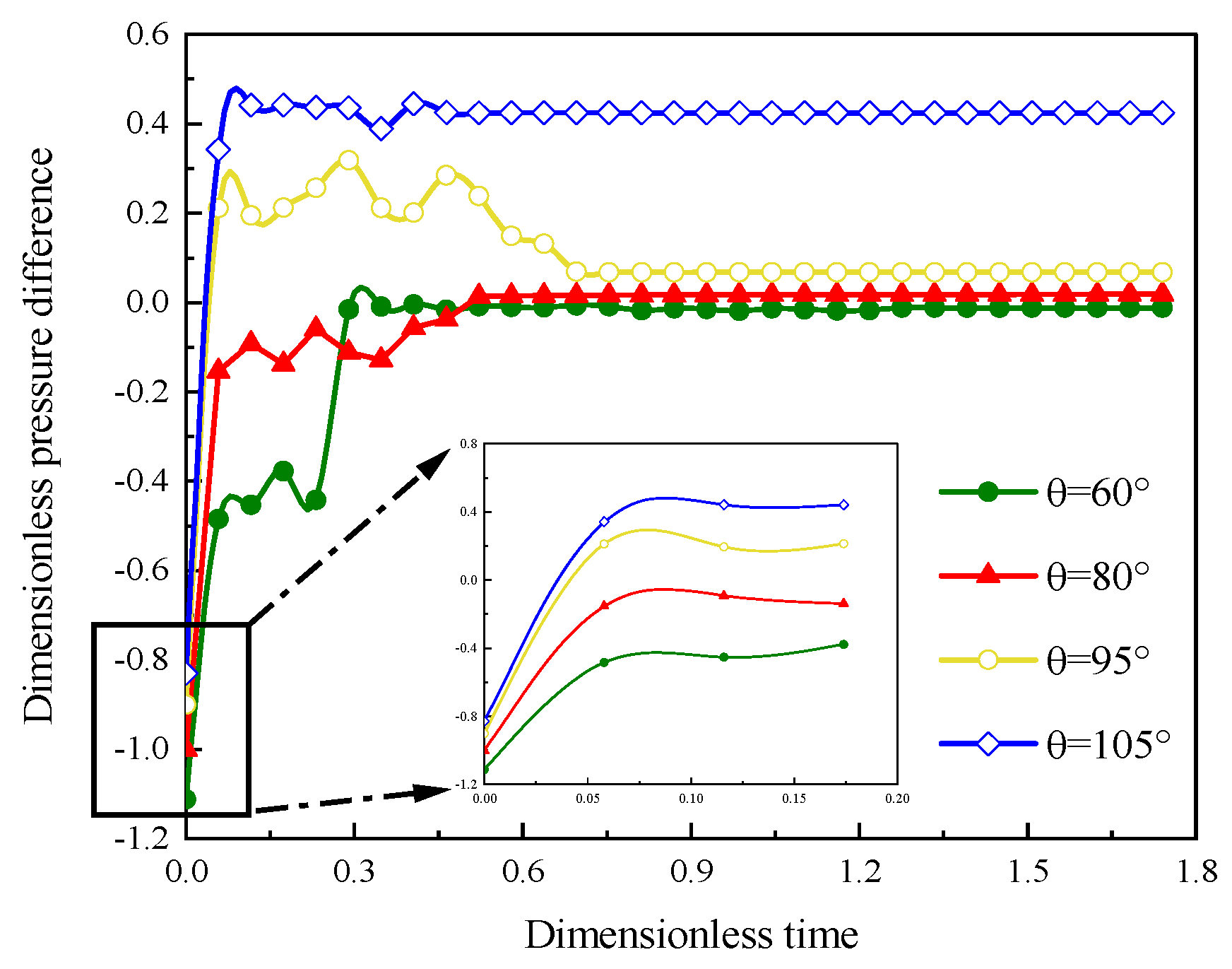
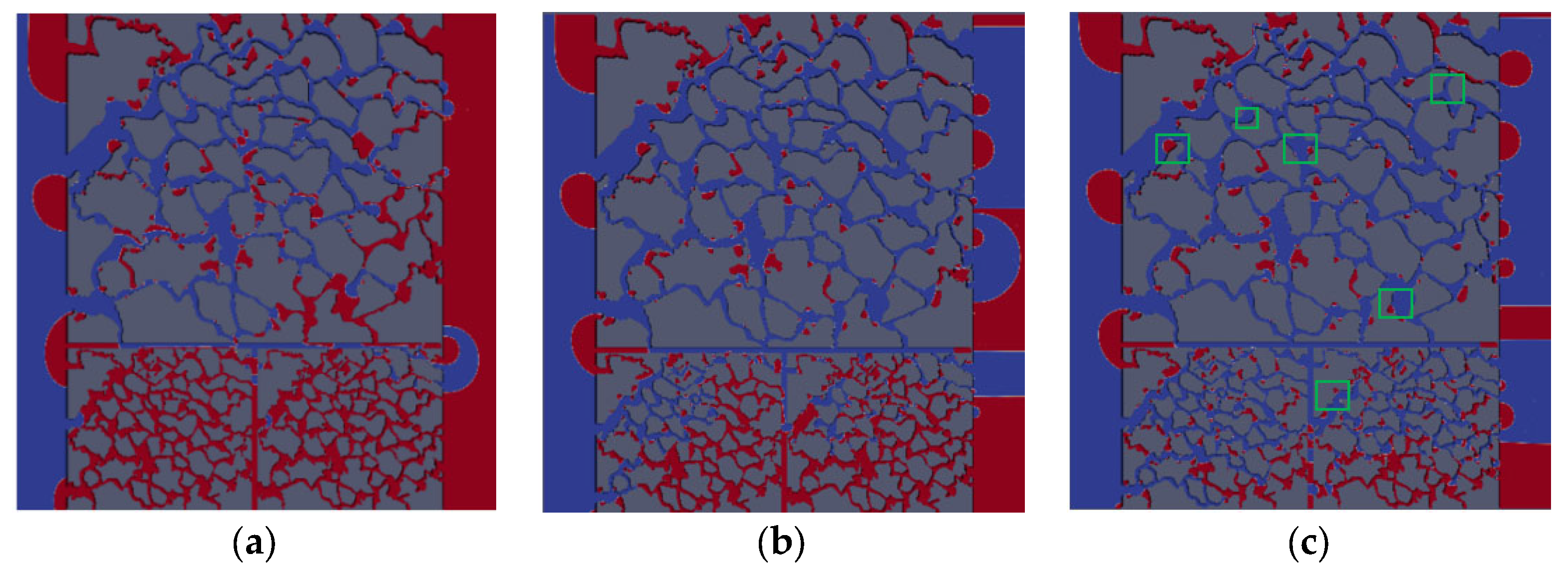

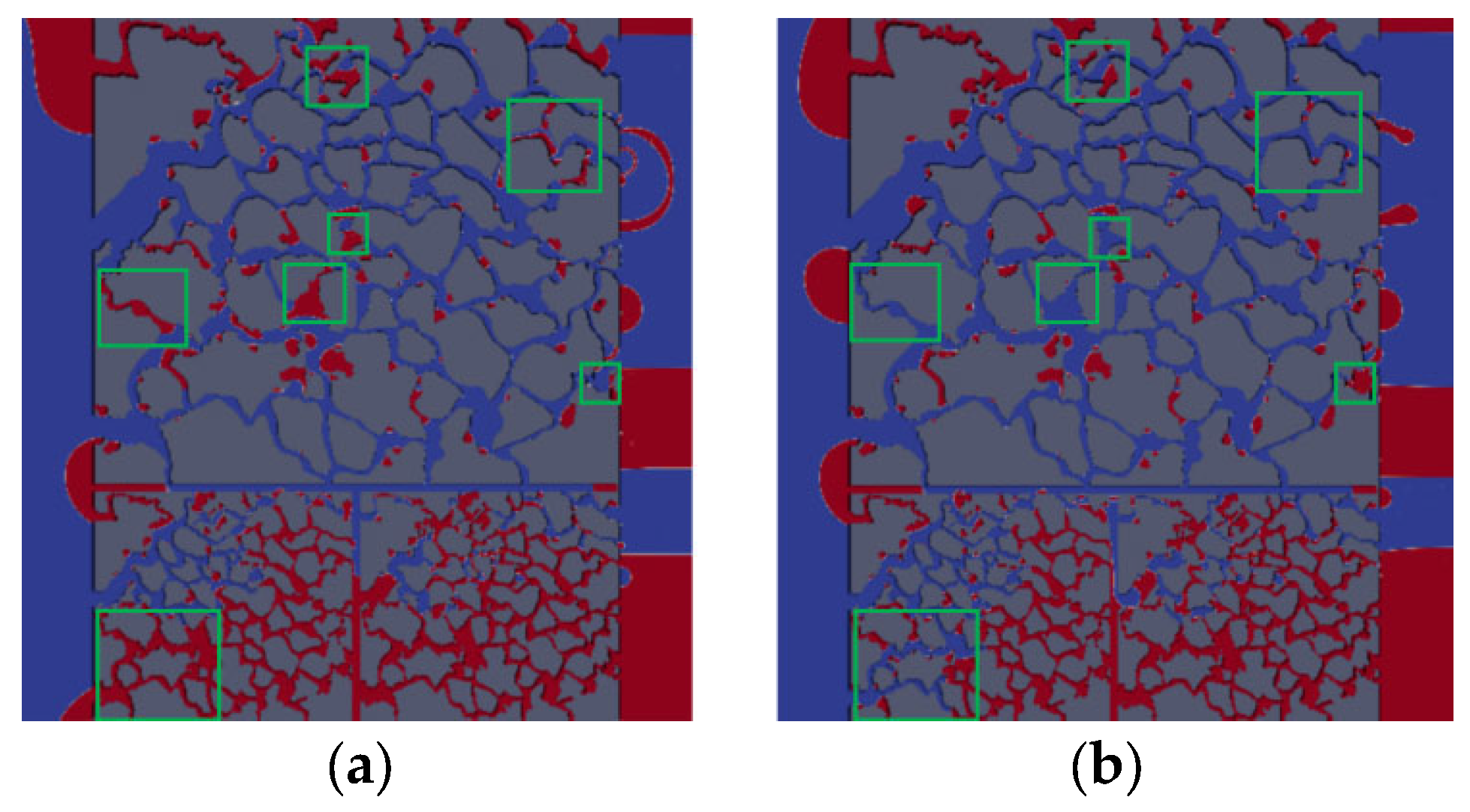


Disclaimer/Publisher’s Note: The statements, opinions and data contained in all publications are solely those of the individual author(s) and contributor(s) and not of MDPI and/or the editor(s). MDPI and/or the editor(s) disclaim responsibility for any injury to people or property resulting from any ideas, methods, instructions or products referred to in the content. |
© 2023 by the authors. Licensee MDPI, Basel, Switzerland. This article is an open access article distributed under the terms and conditions of the Creative Commons Attribution (CC BY) license (https://creativecommons.org/licenses/by/4.0/).
Share and Cite
Zhong, H.; Shi, B.; He, Y.; Bi, Y.; Zhao, Y.; Xie, K. The Micro-Flow Mechanism of Polymer Flooding in Dual Heterogeneous Reservoirs Considering the Wettability. Polymers 2023, 15, 4188. https://doi.org/10.3390/polym15204188
Zhong H, Shi B, He Y, Bi Y, Zhao Y, Xie K. The Micro-Flow Mechanism of Polymer Flooding in Dual Heterogeneous Reservoirs Considering the Wettability. Polymers. 2023; 15(20):4188. https://doi.org/10.3390/polym15204188
Chicago/Turabian StyleZhong, Huiying, Bowen Shi, Yuanyuan He, Yongbin Bi, Yu Zhao, and Kun Xie. 2023. "The Micro-Flow Mechanism of Polymer Flooding in Dual Heterogeneous Reservoirs Considering the Wettability" Polymers 15, no. 20: 4188. https://doi.org/10.3390/polym15204188
APA StyleZhong, H., Shi, B., He, Y., Bi, Y., Zhao, Y., & Xie, K. (2023). The Micro-Flow Mechanism of Polymer Flooding in Dual Heterogeneous Reservoirs Considering the Wettability. Polymers, 15(20), 4188. https://doi.org/10.3390/polym15204188





